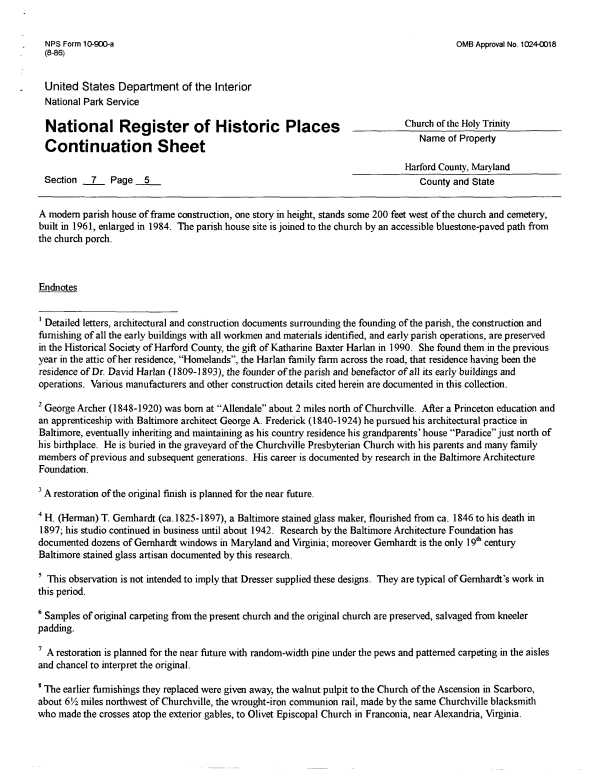 |
||||
|
DEPARTMENT OF HOUSING AND COMMUNITY DEVELOPMENT, MARYLAND HISTORICAL TRUST (Historic Sites Survey) var.d. MSA SE16-8 Image No: se16-8-0352 Enlarge and print image (65K) |
 |
||||
|
DEPARTMENT OF HOUSING AND COMMUNITY DEVELOPMENT, MARYLAND HISTORICAL TRUST (Historic Sites Survey) var.d. MSA SE16-8 Image No: se16-8-0352 Enlarge and print image (65K) |
| NPS Form 10-900-a OMB Approval No. 1024-0018 (8-86) United States Department of the Interior National Park Service National Register of Historic Places ___ChurchoftheHolyTrinity n *_. ,. f^. < Name of Property Continuation Sheet Harford County, Maryland Section 7 Page 5 County and State A modern parish house of frame construction, one story in height, stands some 200 feet west of the church and cemetery, built in 1961, enlarged in 1984. The parish house site is joined to the church by an accessible bluestone-paved path from the church porch. Endnotes 1 Detailed letters, architectural and construction documents surrounding the founding of the parish, the construction and furnishing of all the early buildings with all workmen and materials identified, and early parish operations, are preserved in the Historical Society of Harford County, the gift of Katharine Baxter Harlan in 1990. She found them in the previous year in the attic of her residence, "Homelands", the Harlan family farm across the road, that residence having been the residence of Dr. David Harlan (1809-1893), the founder of the parish and benefactor of all its early buildings and operations. Various manufacturers and other construction details cited herein are documented in this collection. 2 George Archer (1848-1920) was born at "Allendale" about 2 miles north of Churchville. After a Princeton education and an apprenticeship with Baltimore architect George A. Frederick (1840-1924) he pursued his architectural practice in Baltimore, eventually inheriting and maintaining as his country residence his grandparents' house "Paradice" just north of his birthplace. He is buried in the graveyard of the Churchville Presbyterian Church with his parents and many family members of previous and subsequent generations. His career is documented by research in the Baltimore Architecture Foundation. A restoration of the original finish is planned for the near future. 4 H. (Herman) T. Gemhardt (ca.1825-1897), a Baltimore stained glass maker, flourished from ca. 1846 to his death in 1897; his studio continued in business until about 1942. Research by the Baltimore Architecture Foundation has documented dozens of Gemhardt windows in Maryland and Virginia; moreover Gemhardt is the only 19th century Baltimore stained glass artisan documented by this research. 5 This observation is not intended to imply that Dresser supplied these designs. They are typical of Gemhardt's work in this period. 6 Samples of original carpeting from the present church and the original church are preserved, salvaged from kneeler padding. A restoration is planned for the near future with random-width pine under the pews and patterned carpeting in the aisles and chancel to interpret the original. 8 The earlier furnishings they replaced were given away, the walnut pulpit to the Church of the Ascension in Scarboro, about 6!/2 miles northwest of Churchville, the wrought-iron communion rail, made by the same Churchville blacksmith who made the crosses atop the exterior gables, to Olivet Episcopal Church in Franconia, near Alexandria, Virginia. |